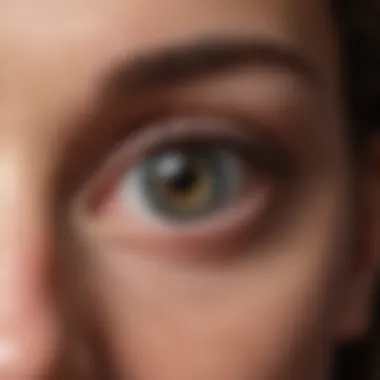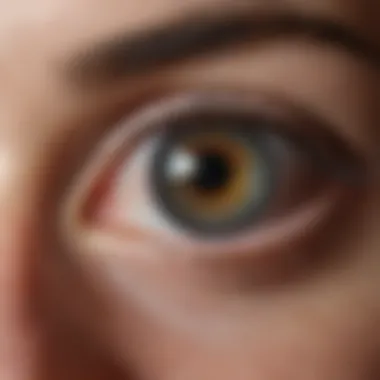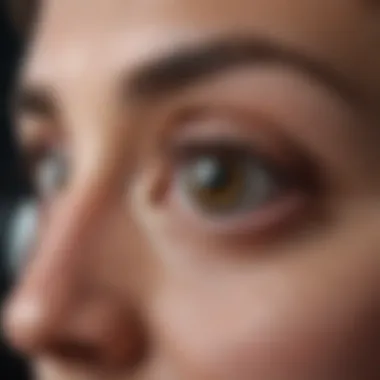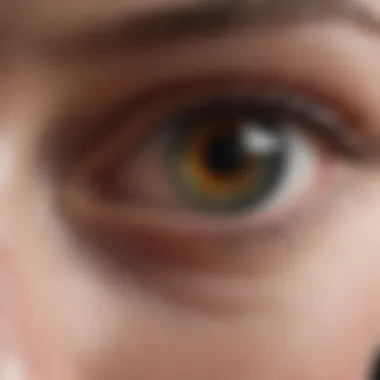Understanding Pseudophakia: Insights and Advances


Intro
Pseudophakia is a term that often comes up in discussions about cataract surgery and eye health. To put it simply, it refers to the condition where a natural lens of the eye is replaced with an artificial intraocular lens (IOL). This occurrence is typically the result of cataract surgery, which is one of the most common surgical procedures worldwide. The transition from a natural to a synthetic lens is significant; it not only addresses the visual impairments caused by cataracts but also brings along certain implications and considerations both for healthcare professionals and patients alike.
Why it Matters
Understanding pseudophakia is pivotal for several reasons. For one, it highlights the advancements in ocular surgery and the technology behind artificial lenses. The choice of lens, the surgical techniques involved, and the postoperative care are all crucial elements that affect outcomes and overall patient satisfaction. In a world where the population is aging and the prevalence of cataracts is rising, knowledge about this topic becomes even more critical.
In light of this, the focus will be on not just the technical aspects of the surgery, but also the patient experience following the operation. By delving into the types and implications of the intraocular lenses used, we can derive a broader understanding of how these innovations shape modern eye care. Additionally, highlighting the ongoing research in this field can offer insights into future possibilities for treatment and improved patient experiences.
As we navigate through this article, the objective is to not only inform but also engage professionals, educators, and students who are keen to grasp the nuances of this important topic.
Prologue to Pseudophakia
Pseudophakia is a term that encapsulates the state of having an artificial lens implanted within the eye, typically following cataract surgery. This subject is pivotal because it bridges the intricate world of ophthalmic surgery with the tangible experiences of patients. Understanding pseudophakia not only enhances our grasp of surgical outcomes but also sheds light on the broader implications for visual health in the aging population. With the ever-increasing incidence of cataracts, the rise of pseudophakia has serious relevance in modern eye care practices.
In this exploration, we will consider its significance from multiple angles, including clinical implications, patient experiences, and technological advancements. By starting with the foundational definition and historical context, we aim to build a framework that delves deeper into the layers of how this condition integrates into the world of eye health.
Definition and Clinical Significance
Pseudophakia arises when a cataract, typically a clouding of the natural lens due to age or other factors, is removed and replaced with an intraocular lens (IOL). This surgical transition allows for restored vision that may otherwise be lost. The condition’s clinical significance is multifaceted: it paves the way for improved quality of life by reducing visual impairment, which can impact everything from day-to-day tasks to driving.
Moreover, the choice of IOL type can affect post-operative outcomes. For instance, some patients may experience challenges with glare or reduced contrast sensitivity, making it imperative for practitioners to tailor lens selection to individual needs. Therefore, staying updated on the latest lens technologies and understanding their role in pseudophakia becomes paramount for eye care professionals.
Historical Background
The journey to pseudophakia is steeped in surgical evolution. The roots of cataract surgery date back centuries, where ancient techniques were rudimentary at best. However, the introduction of the intracular lens in the 20th century marked a turning point. Initially, surgeons would perform cataract extraction without lens replacement, leading to significant visual limitation.
As time went on, the first IOLs were crafted from materials like polymethyl methacrylate (PMMA), which facilitated the gradual shift towards modern surgical practices. Over the years, advancements in surgical techniques—like phacoemulsification—have minimized recovery times and improved outcomes significantly. This rich history is critical to appreciating the advancements we now have and how they contribute to the concept of pseudophakia.
"Understanding the evolution of cataract surgery is essential, as it gives context to the innovations and choices available today."
Thus, the exploration of pseudophakia intertwines with broader themes in medical history, technological progress, and the ongoing commitment to enhancing patient outcomes.
Cataract Surgery and Pseudophakia
Cataract surgery is a pivotal moment in the journey for many individuals experiencing declining vision due to cataracts. This procedure not only addresses the immediate issue of cloudy lenses but also sets the stage for a potential transformation toward clearer sight through pseudophakia, which occurs when an artificial intraocular lens replaces the natural lens. Understanding the intricate relationship between cataract surgery and pseudophakia is crucial for appreciating the pathway toward improved visual rehabilitation and eye health.
Indications for Surgery
Cataract surgery is recommended when cataracts interfere with daily life. The decision to proceed with surgery typically hinges on a variety of factors:
- Visual Impairment: Patients often report blurriness, double vision, or halos around lights, which can impede activities such as reading or driving.
- Impact on Quality of Life: If a cataract hinders one’s ability to perform cherished activities or affects overall well-being, surgery may become necessary.
- Patient’s Age and Health: Generally, the older the patient, the more likely cataract surgery will be considered. However, individual health status also plays a role in determining suitability for the procedure.
The surgical decision is not solely clinical; it also encompasses personal stories and life circumstances. For example, a grandmother eager to see her grandchildren’s faces clearly again may prioritize her cataract procedure over purely medical indications. This emotional aspect underscores the broader significance of cataract surgery, where the aim transcends mere vision correction.


Surgical Techniques
Cataract surgery employs a variety of techniques, each with its unique approach and nuances. The most prevalent method is phacoemulsification, which involves a few key steps:
- Preparation: The patient is given anesthetic drops, and the area around the eye is cleaned to prevent infection.
- Incision: A small incision is made on the cornea, creating a gateway to the eye’s internal structures.
- Cataract Removal: An ultrasound probe is inserted through the incision to break up the cloudy lens into tiny pieces. This process is often compared to a gentle crafting of a delicate sculpture, requiring precision and expertise.
- Lens Implantation: Once the natural lens is extracted, an intraocular lens (IOL) is inserted. This lens works to restore clear vision and can vary based on specific patient needs.
- Closure: The incision is so small that stitches might not even be needed, as the eye’s natural healing process generally takes care of it.
An alternative to phacoemulsification is extracapsular cataract extraction, a method used less frequently today. This technique involves removing the entire lens in one piece, which is more invasive and typically reserved for complex cases.
In just a short span of time, the vast evolution of surgical techniques has led to lower complication rates and more successful patient outcomes. For instance, the introduction of femtosecond laser-assisted surgery has improved incision precision and overall safety.
Pseudophakia emerged as a remarkable solution, enabling countless individuals to regain their visual acuity and lead fulfilling lives post-surgery.
In essence, both the indications for surgery and the techniques utilized reflect a nuanced interplay of medical knowledge and patient-centered care. As such, understanding these elements is crucial for appreciating the broader context that surrounds cataract surgery and its transformative potential.
Intraocular Lenses: Types and Applications
Intraocular lenses are a crucial aspect of vision restoration post-cataract surgery and they embody advancements that have greatly improved the quality of life for countless patients. Selecting the right type of lens for each individual patient is essential and requires careful consideration of various factors, including lifestyle, visual needs, and underlying eye health. Throughout this article, we will explore the different types of intraocular lenses—monofocal, multifocal, and toric—and their specific applications.
Monofocal Lenses
Monofocal lenses are the simplest type of intraocular lens. They provide clear vision at one fixed distance, which means they can correct vision either for near or distance. Most commonly, these lenses are set for distance vision, allowing patients to see objects clearly at a distance, like signs or television screens. Many patients who receive monofocal lenses still require glasses for close-up tasks such as reading or sewing.
When a surgeon selects monofocal lenses, cost-effectiveness and reliability are often considered. These lenses have a long track record, ensuring that the surgical outcomes remain predictable.
Key Points:
- Fixed focus on one distance
- Ideal for patients who don’t mind using glasses for different tasks
- Long history of successful use in cataract surgery, often covered by insurance.
Multifocal Lenses
As the name implies, multifocal lenses allow patients to achieve clear vision at multiple distances. This type of lens contains several zones with different optical power, so patients can enjoy better functional vision without constantly relying on glasses. For someone who enjoys reading or other close-up work, a multifocal lens might be a game-changer.
However, it’s worth noting that not every patient is a candidate for multifocal lenses. Some patients may experience visual disturbances, like halos around lights in the evening, but many find the trade-off worth it for the flexibility in their vision.
Considerations:
- Enhanced visual range, potentially reducing reliance on glasses
- May have complications of glare or halos
- Frequently require careful patient selection for the best outcomes.
Toric Lenses
Toric lenses are specifically designed for individuals who have astigmatism alongside cataracts. Astigmatism is caused by an irregular curvature of the cornea, leading to blurred vision. Toric lenses come with varying powers in different meridians, which effectively corrects both the cataract and astigmatism, providing clearer vision.
These lenses can be either monofocal or multifocal. The key advantage is their ability to address two distinct issues with a single lens, improving overall visual outcomes. For individuals who have struggled with astigmatism before their surgery, toric lenses present a significant improvement in their visual quality postoperatively.
Benefits:


- Straightforward solution for astigmatism
- Available in different types to cater to individual vision needs
- Provides better clarity and reduces dependence on corrective lenses.
It is essential for patients to discuss their personal preferences and lifestyle with their eye care professional when considering the type of intraocular lens to ensure the best possible surgical outcome.
Patient Outcomes and Experiences
Patients undergoing cataract surgery and subsequent pseudophakia experience a wide array of outcomes, both successful and challenging. Understanding these outcomes is crucial for both healthcare professionals and patients alike, as they navigate the complexities of recovery and visual rehabilitation. By examining elements such as visual rehabilitation and postoperative complications, we can glean important insights into what to expect and how to optimize experiences in the realm of pseudophakia.
Visual Rehabilitation
Visual rehabilitation after cataract surgery is a vital part of the recovery journey for patients. It represents a concerted effort to restore optimal vision, enhancing not just the quality of life but also independence in daily activities. For many, the transition to a new visual system involving intraocular lenses can feel like learning to ride a bike—there's a mix of excitement and apprehension.
Patients often begin this phase with their eye care providers assessing vision clarity and function. Strategies may include:
- Regular Follow-Ups: Scheduling visits to monitor progress and make necessary adjustments.
- Visual Training: Utilizing exercises that strengthen the brain's adaptation to new visual inputs from the intraocular lens.
- Use of Aids: In some cases, additional aids like magnifying lenses or filters might be recommended to ease daily tasks.
- Patient Education: Understanding how to utilize their new vision, including tips on lighting and distances, which can be critical in daily interactions.
Furthermore, many patients report feeling a sense of renewal and brighter outlooks post-surgery, akin to wiping a foggy window clean. The clarity restored can inspire both gratitude and enthusiasm for life outside the confines of pre-surgery limitations. But it’s also important to note that the journey isn't a one-size-fits-all. Each patient responds differently, and some may face hurdles.
Postoperative Complications
Postoperative complications can cast a long shadow over the patient experience following cataract surgery. Being informed about potential issues is essential for both patients and medical professionals to mitigate risks and prepare adequately.
Some common complications that arise include:
- Posterior Capsule Opacification (PCO): Often referred to as secondary cataracts, PCO occurs when the membrane behind the lens becomes cloudy, leading to vision loss similar to that experienced from primary cataracts. It’s a treatable condition, typically addressed through a simple outpatient procedure called YAG laser capsulotomy.
- Infection: Though exceedingly rare, infections such as endophthalmitis can develop post-surgery. This condition requires immediate attention to prevent severe vision loss.
- Intraocular Pressure Changes: Some patients may experience fluctuations in eye pressure, necessitating management with medication or further intervention.
- Visual Disturbances: Glare, halos, and double vision can occur, particularly with certain intraocular lens types. Adjustments or alternative lenses may be required based on the severity of symptoms.
Addressing these complications head-on is vital. Patients should communicate openly with their healthcare teams to address concerns swiftly. A proactive approach in understanding risks and engaging in patient education can mitigate the impacts of such complications, fostering a smoother recovery and a more fulfilling overall experience.
Overall, the journey post-cataract surgery is a blend of challenges and triumphs. Recognizing the importance of visual rehabilitation and being aware of potential complications equips patients to navigate their paths more effectively.
Impact of Technology on Pseudophakia
The role of technology in the field of pseudophakia cannot be overstated. As advancements in medical technology evolve, they bring a wave of improvements that directly impact patient care, surgical techniques, and postoperative outcomes. The growing sophistication of intraocular lenses and surgical methods fosters an environment where not only the technical quality of surgery improves but also enhances the overall patient experience. When it comes to pseudophakia, these technological strides offer the promise of not just addressing vision problems but also providing patients with a chance to reclaim their quality of life.
Advancements in Lens Design
Recent years have ushered in a plethora of innovations in lens design for pseudophakia. The evolution of intraocular lenses was marked by a shift towards customization. Modern lenses can now be tailored to individual patient needs, addressing unique conditions such as astigmatism or presbyopia. For instance, toric lenses are designed to correct astigmatism, while multifocal lenses can provide a range of vision including both near and far without the need for glasses.
Moreover, new materials have made these lenses softer, more biocompatible, and resistant to opacification. This minimizes the chances of complications that seem like unexpected storms on an otherwise clear horizon. The manufacturing techniques have also advanced, resulting in thinner and lighter lenses, allowing for easier implantation and potentially improving comfort post-surgery.
In terms of surgical outcomes, the precision of lens placement is enhanced through computer-guided systems. These systems help in measuring the eye’s dimensions with unparalleled accuracy, which is critical for achieving optimal lens position. It’s clear that these advancements not only reduce the risk of complications but also empower surgeons in making informed decisions that suit the patient's specific anatomical and visual needs.
Surgical Innovations
Surgical techniques have also undergone significant transformation, evolving into a more artful and precise endeavor. The introduction of femtosecond laser technology offers a leap forward in cataract surgery, allowing surgeons to perform more controlled and delicate procedures. This technology facilitates the breaking up of cataracts and the precise creation of incisions with impressive accuracy, minimizing trauma to surrounding tissues.


Many surgeons now utilize phacoemulsification, which combines ultrasound energy to dissolve cataracts before removal. This less invasive approach reduces recovery time and promotes quicker rehabilitation. On top of that, advancements in imaging technology, including optical coherence tomography, allow for detailed visualization of eye structures, assisting surgeons to tailor their approach to individual patients.
In summary, technology serves as the backbone of progress in the realm of pseudophakia. With each innovative step forward, patients stand to benefit greatly, enjoying enhanced experiences throughout their surgical journey and significantly improved outcomes in their daily lives.
"The eye is the window to the soul, but with modern technology, it can also be the door to clear vision."
Future Directions in Research
The field of pseudophakia is constantly evolving, influenced by advancements in technology and scientific understanding. As researchers delve deeper into this complex subject, several pivotal directions warrant attention. By focusing on how these emerging trends can reshape patient care and surgical outcomes, we glimpse a brighter future for those affected by cataracts and their surgical interventions.
Emerging Lens Technologies
In the realm of pseudophakia, one cannot overlook the role of intraocular lenses. With the technology of lens design advancing at a dizzying pace, new materials and configurations are pushing the boundaries of vision restoration. Innovative lenses are now being developed, designed for greater customization to individual patients’ needs. For example, adaptive lenses that adjust their focus in response to lighting changes are being tested, presenting immense potential for dynamic correction of vision.
These advancements include:
- Bio-compatible materials: Lenses made from new polymers that reduce the risk of inflammation and other complications post-surgery.
- Smart lenses: Incorporating technology that enhances focus and may even allow users to perceive depth more accurately. Reminds one of those sci-fi films where technology enables superhuman abilities!
- Extended depth-of-focus lenses: An exciting area of research where lenses provide a broader range of clear vision, helping to address both near and far sightedness simultaneously.
The advent of these technologies promises not just better vision but also a decrease in dependence on glasses.
Addressing Complications
While the horizon looks promising, it is equally crucial to focus on addressing complications that may arise post-cataract surgery. Although many patients enjoy restored vision, some face challenges such as glare, halos and even rare instances of infection. Consequently, ongoing research is imperative to mitigate these issues and enhance overall outcomes.
Key areas of focus include:
- Identifying risk factors: Some patients might be more predisposed to certain complications based on their medical history or individual characteristics. Research into genetic predispositions or comorbidities could lead to tailored preoperative assessments, allowing for better risk management.
- Enhanced surgical training: Continuous improvements in surgical techniques and the training of surgeons can significantly reduce complication rates. Utilizing virtual reality and simulation technology can offer surgeons real-time feedback for skill improvement.
- Postoperative care protocols: Clear guidelines and protocols for monitoring patient recovery help detect complications early, ensuring prompt intervention. A stitch in time saves nine, as they say!
The path forward in addressing complications appears to be intertwined with both technological advancements and the refinement of surgical practices. Understanding and acknowledging these challenges is essential for anyone venturing into the field of pseudophakia.
"As we explore the future of pseudophakia, we must prioritize innovations that not only enhance patient outcomes but also ensure their safety and overall quality of life."
Finale
The end of this exploration into pseudophakia holds significant weight, as it stitches together the threads of understanding regarding this important clinical condition. Pseudophakia, formed as a result of cataract surgery, represents not just a change in the anatomy of the eye, but also a milestone in the journey towards enhanced visual health for many individuals. The discussion so far has illuminated various facets of pseudophakia, from the intricacies of surgical techniques to the array of intraocular lenses that play a crucial role thereafter.
Summary of Key Points
In summarizing the key points covered, it is essential to reflect on:
- Definition and Significance: Pseudophakia is the presence of an artificial lens after cataract surgery, allowing improved vision.
- Patient Experiences: Insights into the visual rehabilitation process and how patients adapt post-surgery.
- Technological Impact: The remarkable advancements in lens design and the proliferation of surgical techniques that refine outcomes.
- Future Directions: Emerging research and potential innovations that promise to enhance the efficacy and safety of eye care procedures in future.
These points underscore not just the complexity of the condition but also the ongoing effort from the medical community to ensure the best outcomes for patients.
The Future of Eye Care
Looking ahead, the future of eye care is a landscape painted with both promise and innovation. As research continues to propel forward, a few noteworthy considerations emerge:
- Emerging Lens Technologies: The development of smart lenses that adjust to varying lighting conditions or enhance visual acuity at different distances could redefine treatment paradigms.
- Minimally Invasive Techniques: The surgical field is likely to witness even less invasive approaches, reducing recovery times and postoperative complications.
- Patient-Centric Innovations: Increasing emphasis on personalized medicine, where treatment plans are tailored more accurately to individual patient needs, preferences, and anatomical specifics.
"The eye is the window to the soul," so as technology advances, it fosters deeper insights not only into ocular health but overall well-being, presenting new avenues for research and practice in the field of ophthalmology.







